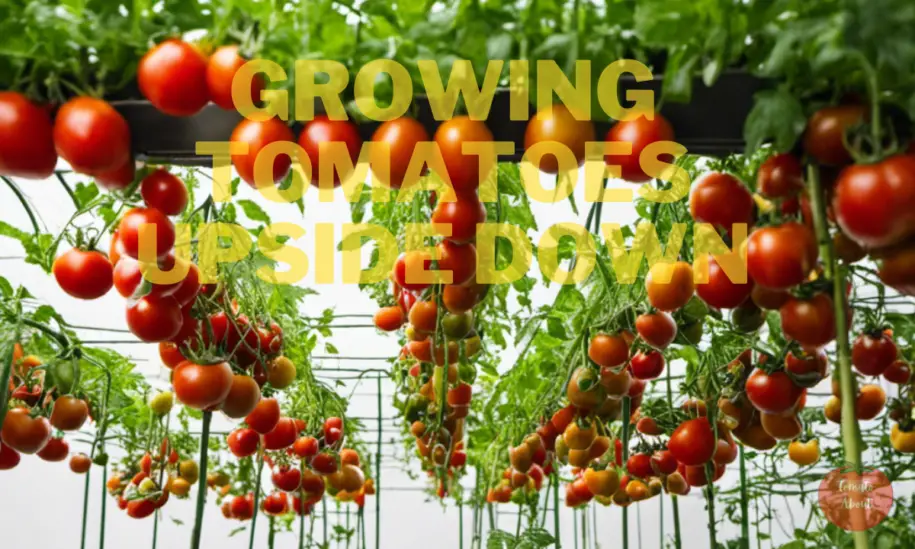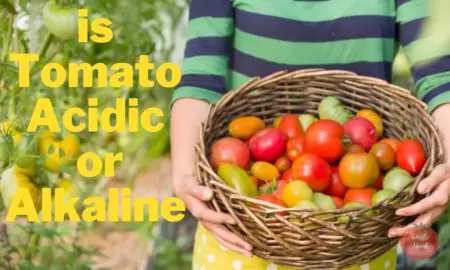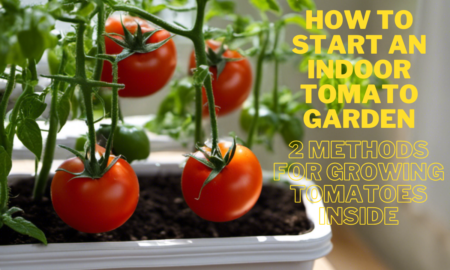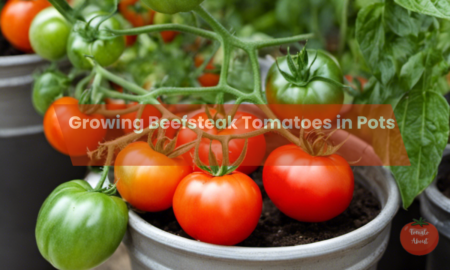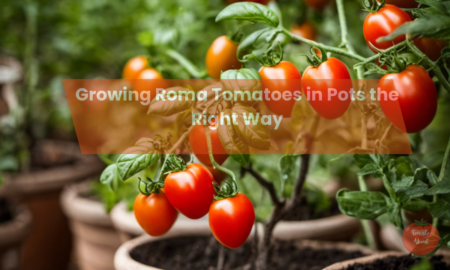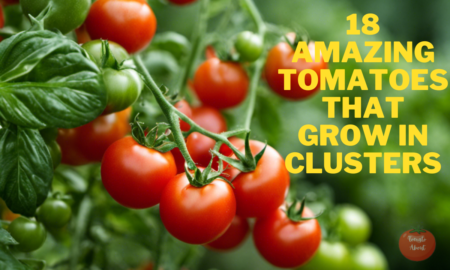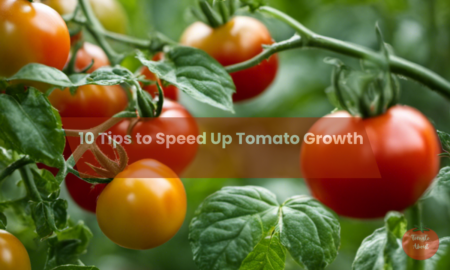Key Takeaways
- Upside-down tomato gardening is a space-saving solution for growing fresh tomatoes in small areas.
- It maximizes yields, improves air circulation, and reduces soil-borne diseases.
- Compact tomato varieties are ideal for upside-down growing, while larger varieties may pose challenges.
- Sturdy support structures are essential to handle the weight of hanging tomato planters.
- Proper planting, care, and troubleshooting techniques ensure a successful upside-down tomato garden.
As a tomato lover, you know there’s nothing better than biting into a fresh, ripe tomato straight from the vine. But lack of space to grow tomatoes is a common frustration for many gardeners. Getting good sunlight, fighting off pests, and having room for sprawling vines are issues, especially in small spaces.
Luckily, growing tomatoes upside down provides a clever solution! With just a sunny spot, a sturdy hook, and a container, you can cultivate mouthwatering tomatoes on even the tiniest balcony or patio.
In this comprehensive guide, you’ll discover everything you need to successfully grow tomatoes upside down. From picking the best compact varieties to troubleshooting common problems, you’ll become an expert in harvesting homegrown tomatoes no matter your garden size. Let’s get growing!
What is Upside-Down Tomato Gardening
Upside-down gardening is an innovative technique that allows you to grow vining vegetables and fruits vertically rather than horizontally across the ground.
By suspending containers upside down, the plants are inverted with their vines dangling below. This enables the vines to grow downwards naturally towards sunlight, forming fruits along the cascading stems.
For urban gardeners and anyone with limited outdoor space, upside-down gardening is a game changer. A small balcony, patio, or even just a sunny window provides ample space to cultivate tomatoes using this method.
The main advantages you’ll enjoy by growing tomatoes upside-down include:
- Maximize yields in confined areas by utilizing vertical space
- Improved air circulation and sun exposure result in healthier, more robust growth
- Reduces soil-borne disease problems
- Deters some pests since insects have difficulty accessing inverted plants
- Eliminates the need for staking – vines grow down naturally with gravity
- Convenient harvesting at waist height instead of ground level
There are few drawbacks of growing tomatoes upside down
- Requires sturdy support structure
- Can be challenging for larger/heavier tomatoes
- More prone to drying out, needing frequent watering
- Sunscald risks if fruits not shaded
- Potential for vines to snap from weight
- Trellising often required as vines grow
- Drainage and soil leakage concerns
- May deter pollinators from reaching blooms
While inverted plants have some specialized needs, the payoff is abundant vine-ripened tomatoes in spaces where ordinary gardening isn’t possible. Keep reading to learn how to master upside-down tomato growing for your highest yields ever!
Choosing Tomato Varieties Perfect for Growing Upside Down
The key to thriving upside-down tomatoes is starting with compact, container-friendly varieties. Avoid giant indeterminate beefsteak tomatoes, which grow huge vines with heavy fruits. These large tomatoes require extensive trellising and can snap stems when suspended upside down.
Instead, look for dwarf tomato varieties bred specifically for containers and hanging baskets. The best tomatoes for upside-down growing include:
- Tumbler Tomatoes: An ultra-compact bush variety that thrives in hanging baskets. The tidy 18-inch plants pump out masses of sweet red cherry tomatoes yet stay perfectly proportioned for their containers.
- Sunset Patio Tomatoes: Another dwarf variety ideal for patios and balconies. Sunset Patio forms clusters of tasty 4-ounce tomatoes on a petite plant. Staking and pruning aren’t required.
- Upsidedown Tomatoes: This aptly named patio tomato was developed especially for upside-down growing. The short plants yield abundant crops of plump 2-3 ounce fruits perfect for salads.
- Window Box Roma Tomatoes: A heavy-producing Roma-type tomato bred for small spaces. You’ll get bountiful harvests of meaty red paste tomatoes from these compact 2-foot tall plants.
- Tumbling Tom Tomatoes: One of the best upside-down cherry tomatoes. These vigorous cascading vines stay neat and tidy while pumping out tons of sugary sweet red fruits.
When browsing tomato seed catalogs and nurseries, look for container-friendly compact varieties under 1 foot tall. Dwarf tomatoes with determinate vines stay bushy and naturally self-supporting for stress-free upside-down gardening.
Setting Up a Sturdy Support System for Hanging Tomato Planters
Before planting upside-down tomatoes, the most crucial step is installing a secure support structure. When filled with soil, your hanging tomato planter can weigh around 50 pounds or more! The hook, railing, or bracket needs to safely handle this heavy weight for the entire growing season.
Here are some excellent support ideas for suspending upside-down tomato planters:
- Sturdy porch beams or exposed ceiling rafters make great anchors for hanging tomato baskets using heavy-duty hooks. Just ensure they are load-bearing.
- Iron railings and deck posts work perfectly for securing S-hooks and eye bolts. Attach to the vertical bars or pillars, not the horizontal railing.
- Wall-mounted bracket supports like the Elite Tomato Hanger securely bolts to vertical surfaces like fencing or siding while holding up to 75 lbs.
- Upside-down tomato stands like the Tomato Hanger Steel Bracket Set combine sturdy stakes and hooks for versatile freestanding use in any yard or garden.
- For heavy-duty weight capacity, the Cedar Trellis Tomato Cage by Gardener’s Blue Ribbon can support up to 150 pounds. Use with larger tomato varieties.
When installing upside down tomato supports, check the weight rating and anchor securely. A dangling 50 pound planter puts immense strain on attachments, so over-engineer the support for safety. Don’t take shortcuts or else you may end up with a huge mess of soil, broken vines, and smashed tomatoes on the ground!
Picking the Perfect Upside Down Tomato Planters
An ideal upside down planter for tomatoes should be lightweight, drain well, and provide enough room for roots to grow. You also want to choose an aesthetically pleasing container that fits your patio or balcony décor.
Here are some excellent tomato planter ideas to consider trying:
- 5-gallon buckets are a popular choice. Drill drainage holes in the bottom then decorate with paint or stencils for a trendy upcycled hanging planter.
- For a fashionable look, try woven wicker hanging baskets lined with moss. The 12+ inch width offers ample room for tomato roots and they come in various shapes like rounds or cones.
- Fabric grow bags and felt planter bags are lightweight and allow air to permeate roots while also draining well. Choose taller narrow bags for tomatoes rather than low wide ones.
- For urban chic style, stainless steel wire hanging baskets have a modern vibe. Look for larger-sized wire planters at least 14 inches wide and 10 inches deep for tomatoes.
- Upside-down specific planters like the Topsy Turvy allow easy filling from the top opening and have a stabilizing rim design.
No matter which type of container you pick, be sure to cut or drill a 3-inch drainage hole in the bottom. Then protect the hole with mesh screen to allow roots through but contain the soil.
How to Planting Your Upside Down Tomatoes
Once your supports are secured and planters prepped, it’s time for the fun part – planting! Follow these steps when transplanting young tomato seedlings into your upside down hangers:
- Partially fill the planter with quality potting mix, leaving at least 4 inches of space at the top. Pack down the soil to prevent it escaping through the bottom hole.
- Water the soil until it’s damp but not soaked. Proper moisture will help the roots establish quickly.
- Remove the tomato gently from its nursery pot, handling the stem carefully. Try to keep the root ball intact.
- Insert the root ball and lower stem through the drainage hole so the upper part sits above the planter rim. The bottom 1/3 of roots should extend below.
- Pack more damp potting mix tightly around the exposed roots and lower stem to stabilize the plant. The stem should stand firmly upright.
- Allow the bottom of the planter to rest on the ground for a few days. This helps the newly transplanted tomato seedling establish before hanging.
- When the plant appears healthy and actively growing, hang the planter from your support using hardware that can hold significant weight when mature.
Caring Tips to Keep Your Upside Down Tomato Plants Thriving
Here are some tips for keeping your hanging tomato plants healthy and bountiful:
- Check the soil daily, as containers dry out faster than garden beds. Water immediately if the top few inches become dry. Tomatoes need at least 1-2 inches of water per day.
- Apply a water-soluble tomato fertilizer every 2-3 weeks according to label instructions. You can also use compost tea or fish emulsion to provide nutrients.
- Prune back excess foliage to allow sunlight and airflow. But avoid over-pruning upside-down plants, as leaves protect fruits and vines from sunscald.
- Support heavy tomato clusters by gently tying them to attached trellis netting using soft plant tape or twist ties. This prevents detached fruits from falling.
- Pick ripe tomatoes frequently to reduce weight pulling down on vines. Enjoy them fresh or freeze extras to enjoy all winter long.
- Scout for hornworms, aphids, and other common tomato pests. Remove by hand or use organic neem oil and insecticidal soap sprays.
- Monitor for blossom end rot. Prevent this common issue by maintaining even soil moisture and applying a calcium supplement like Rot-Stop.
Troubleshooting Common Upside-Down Tomato Problems
Even when set up properly, you may encounter problems inherent to contending with gravity. Here are some common troubleshooting tips:
- Leggy growth – Increase sunlight exposure. Gently tie stems to stakes or netting for support as needed.
- Drooping leaves – Typically a sign of under-watering. Check soil moisture and water plants daily.
- Wilting plants – Can indicate overwatering. Allow soil to partially dry out between waterings.
- Blossom drop – Improve pollination by gently shaking flowers daily. Maintain even soil moisture.
- Sunscald on fruits – Adjust position to receive afternoon shade if leaves can’t protect ripening tomatoes.
- Damaged vines – Protect delicate stems from wind damage. Tie loose vines to stakes or netting.
Conclusion
Growing tomatoes upside down is an ingenious gardening method that allows anyone, even those with the smallest space, to cultivate fresh vine-ripened tomatoes. While this unique technique does require some special considerations, the benefits of maximizing your harvest in a limited area make it worth the extra effort. With the right tomato varieties, sturdy supports, and proper care, you can enjoy growing tomatoes in creative new ways.
Upside down tomato gardening is a fun, rewarding way to produce bountiful crops without extensive beds. This season, consider giving tomatoes a new perspective by planting them upside down!

